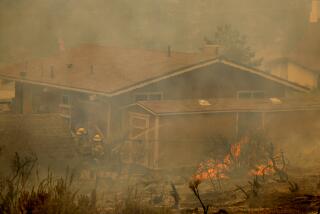Conference Takes Look at Rebuilding Problems : Disasters: With fires, floods and earthquakes, experts agree that the recovery challenges in Southern California are complex.
After the Great Fire of London devoured the city in 1666, the government issued a simple decree: Stop building with so much wood. It was a direct, effective response to disaster.
But at a UCLA conference Friday on disaster recovery, state and federal officials as well as academics and environmentalists agreed that in Southern California today, the problems of rebuilding after fires, floods and earthquakes are more complex.
“It’s easy to identify what the problems are,” said Paul Flores, deputy director of the state’s Office of Emergency Services.
“But it is much harder to find solutions.”
Among the tricky questions: Who should pay for recovery? Should victims be allowed to rebuild in hazardous areas, such as mountainsides? And how much of what are written off as “acts of God” can be prevented?
“We usually find out, when all of the damage is tallied up, that God was not at all at fault,” said Katherine Stone, a Ventura lawyer who represents cities. “There is always someone to point the finger at.”
Most of those attending the daylong workshop sponsored by the UCLA Extension Public Policy Program agreed that while disasters have tragic consequences, they are almost always the result of people building in areas where, ideally, they should not.
Such areas include most of Southern California, a region that owes its scenic beauty to the unstable geologic faults that run much like spider webs miles underground.
“What we humans call disasters are really just part of the natural cycle,” environmental lawyer D. Dwight Worden said. He and others questioned the wisdom of allowing new houses to sprout on charred or collapsed foundations.
“If you build on the train tracks, you should not complain when the train hits you and we should not pay you to rebuild on those same tracks,” Worden said.
Indeed, one solution suggested by some after last fall’s firestorms was for local officials to refuse permission to rebuild in areas prone to wildfires or landslides. Attractive because of its simplicity in theory, most consider the idea unworkable because of its complexity in practice.
Property owners have a Constitutional right to use of their property. The U.S. Supreme Court has ruled that if local governments want private property to remain undeveloped--even if that could save lives--they generally have to buy it.
Yet government often ends up footing at least part of the bill when those same property owners are left homeless by natural disaster. Or worse, the government gets sued by homeowners angry over being allowed to build in a dangerous spot.
“The reason we are still letting people rebuild is because we have no choice,” Laguna Beach City Manager Kenneth Frank said. “If we don’t allow someone to rebuild, we get sued. If we allow them to rebuild and they get swept away, we get sued.”
*
Between 1989 and 1996, federal taxpayers will shell out roughly $7 million a day to bandage the wounds caused by California disasters--from the Loma Prieta to the Northridge earthquakes, according to Federal Emergency Management Agency figures, making California the biggest drain on the national disaster purse.
William Ahern, deputy commissioner of the state insurance department, said there needs to be a fundamental overhaul of the insurance system to spread risks evenly among all residents.
As it is, residents in high-risk fire areas such as the Santa Monica Mountains are subsidized by the state Fair Plan program, which provides low-cost insurance to residences that private companies refuse to cover.
“We now rely on government,” Ahern said, calling it “the least rational, most political, messy system you can think of. . . . “
But spreading the risk further did not rest well with some. Calabasas Planning Commissioner David Brown said he resents paying more in taxes and for insurance so others can live on slide-prone hillsides with great views.
“I’d like to focus the risks on the individual,” Brown said. “They should not pass the risks on to the general public.”
As daunting as rebuilding efforts seem, conference participants said each new disaster makes Southern California better prepared for the next. Earthquakes, for instance, exercise a sort of “structural Darwinism” by destroying weak and old buildings, which can be replaced with newer, more stable ones.
“The earthquake problem in California will never go away,” said Jim Buika, a manager with the Federal Emergency Management Agency. “But we can get better at it and obviously we have.”
More to Read
Sign up for Essential California
The most important California stories and recommendations in your inbox every morning.
You may occasionally receive promotional content from the Los Angeles Times.










